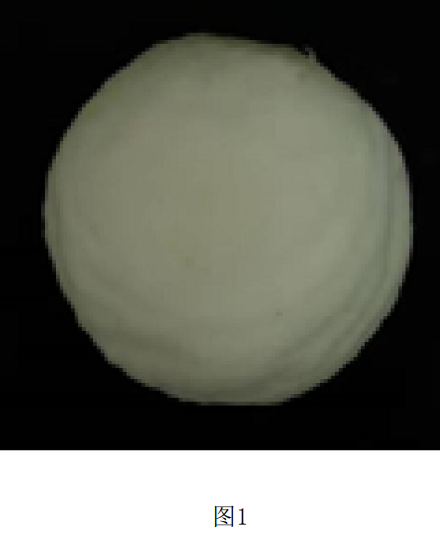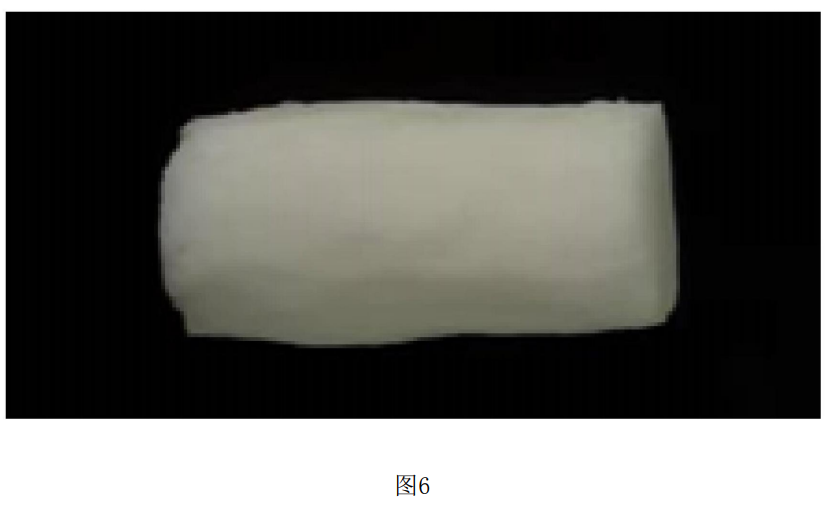Polyurethane|Medical polyurethane cotton balls and method of preparing them
Abstract
The present invention provides a medical polyurethane cotton ball and its preparation method, application, medical polyurethane cotton ball is made from polyurethane sponge by cutting, polyurethane sponge is made from polyether tertiary alcohol, toluene diisocyanate, water, cross-linking agent and auxiliary agent by foaming. The medical polyurethane cotton ball provided by the invention has the advantages of simple preparation method, no biological toxicity, fast liquid instantaneous absorption speed, large liquid absorption, high liquid extrusion rate, no flakes or cotton wool falling off when applied, certain resilience, easy to save, etc. Polyurethane cotton ball can be used directly in the dry state, it can quickly absorb a lot of wound exudate, reduce the operation time and the use of cotton balls; can absorb iodine or medical alcohol before use, it can once complete a large area of the coating operation, reduce the frequency of cotton ball replacement, improve the efficiency of the coating. The invention provides medical polyurethane cotton ball in the dry and wet state are skin-friendly soft, high comfort, effectively reduce the skin and wound caused by the irritation.
Technical field
The present invention belongs to the technical field of medical materials, especially relates to a polyurethane sponge and its preparation method and application, specifically a medical polyurethane cotton ball and its preparation method and application.

Background technology
Medical cotton ball is a common medical supplies, divided into sterile supply of medical cotton ball and non-sterile supply of medical cotton ball. Aseptic supply of medical cotton balls are widely used in medical institutions care, inspection, surgery and daily disinfection, etc..
At present, medical cotton balls are prepared from sterilized skimmed cotton, not only easy to insects, deterioration, not convenient for long-term preservation, and poor liquid absorption performance, low liquid extrusion rate, resulting in dry medical skimmed cotton balls in wound cleaning can not absorb a large amount of wound exudate, increasing the operating time and the use of medical skimmed cotton balls; Similarly, alcohol or iodine volt skimmed cotton balls absorb a small amount of drugs, can not a time to complete a large area of the coating operation, reduce the efficiency of the coating, increase the frequency of replacement of medical degreasing cotton ball and the amount of liquid. In addition, the medical skim cotton ball is not resilient, as a temporary filler for oral examination and restoration, it is inconvenient for doctors to use, and the patient experience is not good. At the same time, because the medical skim cotton ball texture is not skin-friendly soft, easy to use the process of residual cotton wool, resulting in the treatment of wounds when the comfort is poor, easy to irritate the wound.
Example 1
Under the protection of nitrogen, to 100 .00g of anhydrous polyether tertiary alcohol (ethylene oxide: propylene oxide 30:70, the number of average molecular weight of 6000, the United States Dow’s 6001 model polyol), add 20 .19g of toluene diisocyanate (80% by mass of 2 ,4-toluene diisocyanate and 20% by mass of 2 ,6-toluene diisocyanate). .6-toluene diisocyanate) and stirred at 70°C until the NCO value was stable to obtain polyurethane cotton ball A material;
Mix 100 .00g of deionized water, 0.50g of trimethylolpropane, 33.87g of propanetriol, 13.92g of polymerized siloxane (Y-10366), 7.16g of aliphatic polyoxyethylene (15) ether and 4.78g of dehydrated sorbitol fatty acid ester at 15°C to obtain polyurethane cotton ball material B;
50 .00g of the above A material and 56 .00g of B material will be free foaming by mechanical stirring at 20℃, the speed is 1500rpm, the time is 15s, after foaming to get medical polyurethane cotton ball material;
The molding of the medical polyurethane cotton ball material from the mold, into the 60 ℃ oven heat treatment 4h after the epoxy ethane sterilization, aseptic environment placed in 14 days after the performance test.
The product prepared in Example 1 will be cut into spheres with a mass of 0.5g (as shown in Figure 1), used to absorb the blood and tissue fluid exuded from the wound.
Example 2
Under nitrogen protection, 32.30 g of toluene diisocyanate (100% by mass 2,4-toluene diisocyanate) was added to 100.00 g of anhydrous polyether triol (40:60 ethylene oxide:propylene oxide, number average molecular weight 5000, Dow’s 4701 polyol, USA) and stirred at 80°C until the reaction was stable. NCO value is stabilized to obtain polyurethane cotton ball A material;
Mix 100 .00g of deionized water, 1 .20g of 1 ,3-butanediol, 42 .46g of propanetriol, 10 .22g of polyether triol, 9 .23g of polyoxyethylene ether and 5 .12g of polyoxyethylene sorbitol fatty acid ester at 30°C to obtain polyurethane cotton ball B;
50 .00g of the above A material and 66 .50g of B material will be free foaming with mechanical stirring at 35 ℃, the speed is 1200rpm, time is 15s, after foaming to get medical polyurethane cotton ball material;
The molding of the medical polyurethane cotton ball material from the mold, put into 70 ℃ oven heat treatment 3 .5h after the ethylene oxide sterilization, aseptic environment placed in 14 days after the performance test.
The product prepared in Example 2 is cut into spheres with a mass of 0.5g (as shown in Figure 2), which are used as the absorbent liquid of the medicinal solution (75% medical alcohol and 0.2% iodophor) for the application of medicine, skin disinfection, scrubbing, medical device disinfection and lubrication of small areas.
Example 3
Under nitrogen protection, 39.83 g of toluene diisocyanate (80% by mass of 2,4-toluene diisocyanate and 20% by mass of 2,6-toluene diisocyanate) was added to 100.00 g of anhydrous polyether triol (50:50 ethylene oxide:propylene oxide, average molecular weight of 4000, Bayer 3553 polyol). .6-toluene diisocyanate) and stirred at 90°C until the NCO value was stable to obtain polyurethane cotton ball A material;
100 .00g of deionized water, 13 .58g of propanetriol, 20 .96g of propylene oxide propylene glycol ether, 8.47g of aliphatic polyoxyethylene (15) ether, 1 .65g of sorbitol fatty acid ester, 1 .65g of polyoxyethylene sorbitol fatty acid ester, 2.57g of polyoxyethylene and polyoxypropylene block polymer and 3.85g of polycaprolactone triol were reacted at 25°C. poly(ethylene oxide) and poly(propylene oxide) block polymer and 3.85g of poly(caprolactone) triol were mixed at 25°C to obtain polyurethane cotton ball material B;
50 .00g of the above A material and 76 .90g of B material at 40 ℃ foaming machine foaming, foaming to get medical polyurethane cotton ball material; [0081] the molding of medical polyurethane cotton ball material from the mold, into the 80 ℃ oven heat treatment for 3h after the epoxy ethane sterilization, aseptic environment placed in 14 days after the performance test. The product prepared in Example 3 is cut into cylinders of 2.0 cm in length and 0.5 cm in diameter (as shown in Figure 3) and is suitable for use in the nasal cavity of adults and children for stopping nosebleeds or stopping runny nose.
Example 4
Under the protection of nitrogen, 24.37g of toluene diisocyanate (65% by mass of 2,4-toluene diisocyanate and 2,4-toluene diisocyanate) was added to 100.00g of anhydrous polyether triol (60:40 ethylene oxide:propylene oxide, number average molecular weight of 5000, EP-330N polyol of Shandong Bluestar Dongda Chemical Co. (65% by mass of 2,4-toluene diisocyanate and 35% by mass of 2,6-toluene diisocyanate), and stir the reaction at 100 ℃ until the NCO value is stable to obtain polyurethane cotton ball A material;
Mix 100 .00g of deionized water, 9.23g of propanetriol, 25.34g of propylene oxide propylene glycol ether, 6.69g of aliphatic polyoxyethylene(15) ether, 4.65g of sorbitol fatty acid ester, 2.57g of polyoxyethylene and polyoxypropylene block polymer, 6.93g of polycaprolactone triol and 0.19g of color paste at 40°C. homogeneously to obtain polyurethane cotton ball B material;
50 .00g of the above A material and 62 .50g of B material at 30 ℃ foaming machine foaming, foaming to get medical polyurethane cotton ball material; [0087] the molding of medical polyurethane cotton ball material from the mold, into the 85 ℃ oven heat treatment 2 .5h after the ethylene oxide sterilization, aseptic environment placed in 14 days after the performance test.
The product prepared in Example 4 was cut into a sheet rectangle of 12 .0 cm in length, 8 .0 cm in width, and 0 .5 cm in height (as shown in Figure 4) and used to absorb blood and tissue fluid exuded from a larger area of wounds.

Example 5
Under nitrogen protection, 35.81 g of toluene diisocyanate (80% by mass of 2,4-toluene diisocyanate and 20% by mass of 2,6-toluene diisocyanate) was added to 100.00 g of anhydrous polyether triol (70:30 ethylene oxide:propylene oxide, 3000 number average molecular weight, Dow Model 3033LM polyol, USA). 2,6-toluene diisocyanate), and stirred at 75°C until the NCO value was stable to obtain polyurethane cotton ball A;
100 .00g of deionized water, 3.05g of propylene glycol, and 3.05g of deionized water.

